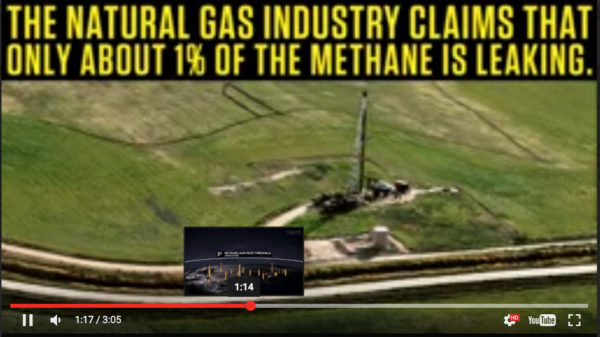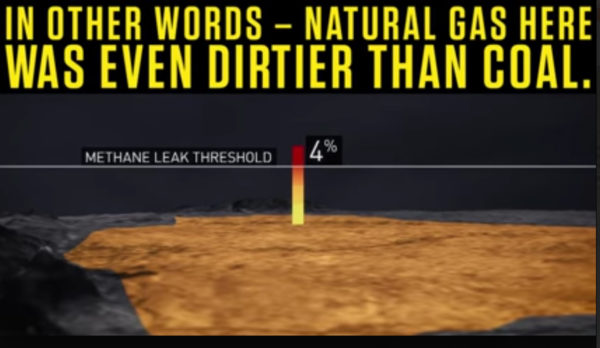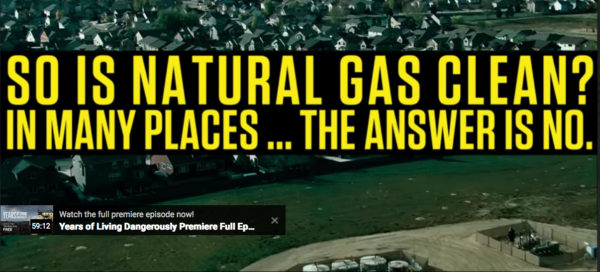National Geographic Show Pushes More Anti-Fracking Methane Misinformation
by Seth Whitehead, Energy in Depth

But the fact remains that the latest independent scientific research, not industry, finds methane leakage rates are WELL below the threshold for natural gas to maintain its climate benefits (ranging from 1.1 to 1.7 percent). And this research happens to be based on the most state-of-the-art technology (and definitely no measurements taken from vans).
Connect with us on Facebook and Twitter!
Follow @EnergyNewsBlog
As silly as it seems, fracking opponents continue to suggest natural gas — a fuel the U.S. Energy Information Administration (EIA) and Intergovernmental Panel on Climate Change (IPCC) acknowledge is the primary reasons the U.S. is the only developed nation in the world to reduce carbon emissions — is somehow part of the problem when it comes to climate change.
The latest example is an upcoming episode of the National Geographic climate change series “Years of Living Dangerously” that bombastically plays up — to an unintentionally hilarious degree — the debunked notion that methane leaks are wiping out all of natural gas’ obvious climate benefits.
In a three-minute teaser video for the soon-to-be-aired “Chasing Methane” episode, former New York Times food and cooking reporter Mark Bittman and a familiar cast of characters make increasingly absurd and inaccurate claims about methane leaks from natural gas development.
First, National Oceanographic and Atmospheric Administration (NOAA) scientist and noted methane emission exaggerator Gaby Petron claims to have found that methane leakage rates are at four percent in Colorado, leading Bittman to set the tone for the entire episode by asking the following:
The fact that Petron — whose past claims of elevated methane leakage have been criticized by EID, Environmental Defense Fund (EDF) and others — based her data on readings taken from a device attached to her van — her van! — is never called into question.
But the absurdities only escalate from there. Next up is a claim that Bittman and a research team found 11 percent leakage rates in Utah’s Uinta Basin. And if that wasn’t scary enough, the video claims 17 percent leakage rates were found in California’s Los Angeles Basin, more than 11 times what nearly every reputable scientific study has found!
Considering scientists agree that natural gas loses its climate advantages when methane leakage exceeds 3.2 percent, the intended takeaway from the episode is clear — natural gas is bad, scary bad — as the following screenshots from the video indicate.
To make matters worse, the video asserts that the notion methane leakage rates are currently well below 3.2 percent is a baseless claim completely attributable to the oil and gas industry.

But the fact remains that the latest independent scientific research, not industry, finds methane leakage rates are WELL below the threshold for natural gas to maintain its climate benefits (ranging from 1.1 to 1.7 percent). And this research happens to be based on the most state-of-the-art technology (and definitely no measurements taken from vans).
Refuting what this “Years of Living Dangerously” episode claims, here is a rundown of the most prominent scientific evidence showing that methane leakage rates from natural gas production are low and well below the threshold for natural gas to maintain its climate benefits.
- Allen et al. (1.5 percent): This landmark 2013 EDF/University of Texas study was the first to measure actual emissions, and it found emissions “nearly 50 times lower than previously estimated by the Environmental Protection Agency,” confirming beyond a shadow of a doubt natural gas’ climate benefits over coal. UT and EDF followed up with two morestudies, which also found very low methane leakage rates. These studies concluded that methane emissions from the upstream portion of the supply chain are only 0.38 percent of production. That’s about 10 percent lower than what they found in their 2013 study.
- 2017 EPA Greenhouse Gas Inventory (1.2 percent): Despite numerous flaws — including extrapolation of emissions data from larger facilities onto smaller facilities, potentially incorrect assumptions about pneumatic controller emissions, and methodology based on flawed so-called “super-emitter” assumptions — EPA’s latest methane emissions data show very low methane leakage rates.
- Littlefield et al. (1.65 percent): This 2017 U.S. Department of Energy National Energy Technology Laboratory study used data from Zavala-Araiza et al. (see below) to synthesize emissions on a national scale. But even though the study finds low emissions, it is worth pointing out that it likely overestimates the leakage rate based to the fact that it extrapolates so-called “super-emitter” data from Zavala-Araiza et al. on a national scale. A recent NOAA study also reveals the “super-emitter” data Zavala-Araiza et al. relied on air measurements likely collected during episodic maintenance events, which skewed emissions higher than they typically would be.
- Lyon et al (1.2 percent): Using “top down” measurements from aircraft over the Barnett Shale in Texas, this 2015 EDF/University of Houston study found very low leakage rates, despite the fact that a limitation of “top down” studies is the fact that methane detected can come from other sources such as agriculture and natural seeps.
- Marchese et al (1.6 percent): This 2015 EDF/Colorado State University study took direct measurements from 114 gathering stations and 16 processing plants across 13 states. Using these measurements, along with EPA data from other segments of the natural gas supply chain, the study found an overall leakage rate that EDF’s Mark Brownstein noted is a “well below what most scientists say is advantageous for the climate.”
- Peischl et al (1.1 percent): This 2015 Colorado University-Boulder/NOAA study used “top-down” measurements from five flights from a NOAA research aircraft over areas that collectively represent half of the U.S.’s total shale gas production (Haynesville, Fayetteville and portions of Marcellus shale). The report goes notes: “[T]he regions investigated in this work represented over half of the U.S. shale gas production in 2013, and we find generally lower loss rates than those reported in earlier studies of regions that made smaller contributions to total production. Hence, the national average CH4 loss rate from shale gas production may be lower than values extrapolated from the earlier studies.”
- Zavala-Araiza et al. (1.5 percent): This 2015 EDF study analyzes data from 12 previous EDF Barnett Shale papers and finds low methane emissions despite being, as the report puts it, “biased toward high-emitters.” Notably, a recent NOAA study reveals the “super-emitter” data Zavala-Araiza et al. relied on air measurements likely collected during episodic maintenance events, which skewed emissions higher than they typically would be. As a result, these “peak” emissions data were inappropriately used to calculate a normal emissions profile.
- Zimmerle et al. (1.3 percent): This 2015 EDF/Colorado State University study finds low overall natural gas system methane leakage rates based on 2,292 onsite measurements from transmission and storage facilities along with additional emissions data from 677 facilities and activity data from 922 facilities.
Even the Intergovernmental Panel on Climate Change’s (IPCC) — not exactly an industry or “climate denier” source — states in its latest climate assessment that numerous studies show methane leakage rates are very low,
“While some studies estimate that around 5% of the produced gas escapes in the supply chain, other analyses estimate emissions as low as 1% (Stephenson et al., 2011; Howarth et al.,2011; Cathles et al., 2012). Central emission estimates of recent analyses are 2%─3% (+/‐1%) of the gas produced, where the emissions from conventional and unconventional gas are comparable.” (emphasis added)
The IPCC also clarifies that even “[t]aking into account revised estimates for fugitive emissions, recent lifecycle assessment indicate that specific GHG emission are reduced by one half” as more power plants are powered by natural gas.
The quantity and quality of the data showing low methane leakage rates from natural gas development is so overwhelming, that it’s simply baffling that fracking opponents continue to play the methane card. But considering the sources in this particular National Geographic program, maybe it shouldn’t be all that surprising.
Cornell professor Anthony Ingraffea — whose absurd claims on methane leakage have been thoroughly debunked by the Department of Energy, MIT, the University of Maryland, Carnegie Mellon and Cornell University — is prominently featured.
And Petron — who, ironically, was a co-author of a recent NOAA study that indicates methane emissions may be overstated — is known for co-authoring a flawed study that claimed leakage rates of 7.7 percent in the Denver-Julesburg Basin. Michael Levi, energy and environment fellow at the Council on Foreign relations, said that the study’s findings were “unsupportable” based on what he terms the “wrong interpretation” of the data, arguing that the emissions rate is a fraction of what Petron and her fellow researchers found. EDF has also said of the study: “conclusions should not be drawn about total leakage based on these preliminary, localized reports.”
Unfortunately, many viewers won’t be privy to the ample scientific data showing methane leakage rates from natural gas development are low when “Chasing Methane” airs later this year. But make no mistake: Despite all the ominous music, alarming graphics and foreboding claims the show will make, it is nothing more than the latest round of anti-fracking methane misinformation.
Connect with us on Facebook and Twitter!
Follow @EnergyNewsBlog







